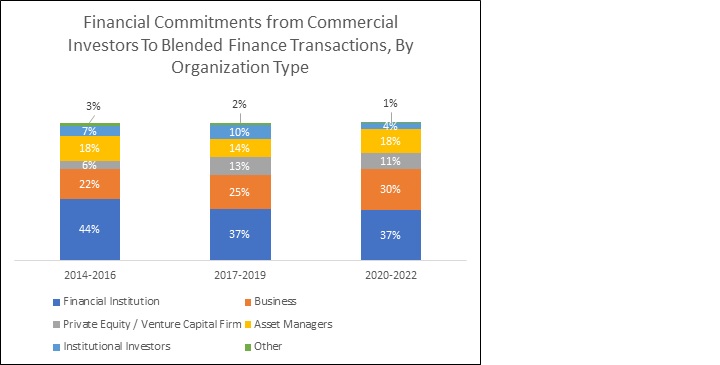
How to invest in blended finance
Net Zero Investor outlines the main challenges and opportunities for institutional investors
The aim of blended finance is to attract private capital to emerging markets by using public or philanthropic capital – known as “concessionary capital” – to de-risk investments that align with sustainable development goals.
This concessionary capital may absorb first losses or go towards technical assistance, grant money or other special guarantees.
Institutional investors tend to perceive emerging markets as having too much risk for too little return, so reducing the risk can help them take the plunge.
The need to boost green capital flows into emerging markets has never been more urgent. In 2020, total global climate finance reached $653 billion, far below the estimated need of at least $4.3 trillion in annual finance flows by 2030 to avoid the worst impacts of climate change. Developing and emerging economies still receive less than a quarter of the total global climate investment despite being disproportionately affected by the climate crisis.
While blended finance is often cited as a possible solution to that finance gap, it is not without its challenges. Not only is each deal bespoke, but the market is still relatively opaque and experimental in nature.
Net Zero Investor has spoken to some of the world’s leading blended finance practitioners to create a quick guide for institutional investors.
Embrace specificity
Every blended finance deal is unique. For example, a climate fund for small and mid-sized African farmers may have a different risk-return profile and concessionary capital elements than say a third-generation ASEAN renewable energy fund or a blue bond.
Bespoke structures are no bad thing. Jennifer Pryce, president and CEO of Calvert Impact, a leading blended finance investor, said, “Cutting and pasting a certain blended finance structure into different geographies or sectors might backfire, because different projects require different kinds of capital and strategies to achieve the desired outcome.”
See the emerging patterns
While bespoke is the name of the game, five distinctive blended finance archetypes have emerged over the last ten years, according to the blended finance platform Convergence.
“That every blended finance deals exhibits one of these basic five structures makes investment decisions easier," said Pryce.
Partly thanks to this modest degree of standardisation, Pryce said blended finance is starting to attract “larger pools of money”. For example, Allianz told Net Zero Investor that it “systematically investigates a large spectrum of potential investments – including blended finance - to finance the low-carbon transition and achieve positive impact.” Arch Reinsurance Limited has a total of $50 million invested in ADM Capital Foundation.
Eco.Business Fund, one of Finance in Motion’s flagship blended finance funds, has grown from $200 million to $700 in the last five years, with a goal to reach $1 billion in the next three years.
Larger vehicles of more than $500 million are essential for attracting institutional investors. Pension funds and insurance companies have more money to invest but they also need more liquidity security and bigger ticket sizes, and only larger vehicles provide this, according to Pryce.
“Attracting institutional capital is a common theme in all our conversations across the development finance ecosystem,” said Convergence’s Andrew Apampa. This can be achieved by designing “simplified structures that are easy to replicate, standardise and be understood by pension funds and insurance companies”.
Despite increased interest from institutional investors, and industry-wide efforts to standardise and make available larger blended finance vehicles, the proportion of institutional investor money in blended finance deals has actually dipped in the last two years, as shown by data provided by Convergence to Net Zero Investor.
Convergence is a one stop shop for all things blended finance and includes the world’s largest blended finance database.

Understand that not everything can be big and simple
Dr Stephanie Bilo, chief client & investment solutions officer at responsAbility, told Net Zero Investor that some impact strategies simply can’t be big or simple enough to attract institutional investors.
She compared two funds: the $500 million institutional investor-friendly Asia Climate Fund (ACF) – due for launch in September – and the smaller but more innovative and complex $100 million Climate Smart Agriculture & Food Systems Fund (CSA).
“We might be able to scale our CSA strategy to a couple of hundred million in the next vintage, but it probably still won’t be large enough for institutional investors to care,” she said. This is because the fund employs a grassroots strategy of directly investing in, and working intensively with, certain small and mid-sized companies in the food and agriculture sector across Africa, Asia Pacific and Latin America. In addition, the fund structure is complex, with multi-tranches including guarantees and a large technical assistance pool.
“Our Asia Climate Strategy, on the other hand, is a much simpler and larger fund structure, and the climate mitigation strategy is much more scalable, generating the kind of ticket sizes that are suitable for institutional investors,” she added.
Be patient and adaptable
“Due to the specific impact and structural requirements, negotiations with concessionary capital providers are always extensive,” Bilo said. That means launching a new blended finance structure usually takes years.
In the meantime, markets can change. The iconic Seychelles Blue Bond – which took about three years to create – is a good example of how delays can create complications.
“Just as it takes time to assemble and structure the capital, it takes time and resources to build absorptive capacity for that capital on the ground,” Pryce said.
Reach out to others
First-time blended finance investors may benefit from contacting experienced impact investors or exploring platforms such as Convergence where various deals (all of them private) are advertised and educational tools made available.
“We were receiving so many calls in 2017 that we actually started a syndication business to help institutional investors,” recalled Pryce.
Pension funds and insurance companies in Germany, Scandinavia, and the Netherlands tend to be most active in the blended finance space, according to Bilo. UK pension funds, encouraged by such initiatives as the “Financing a Just Transition Alliance” (FJTA) and the general momentum, are beginning to take more interest.




